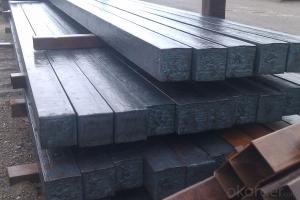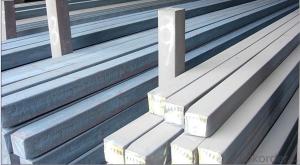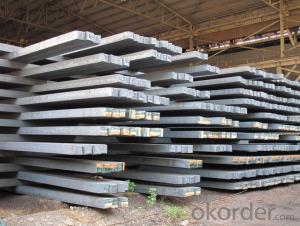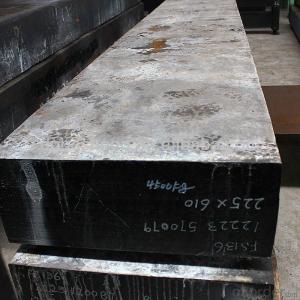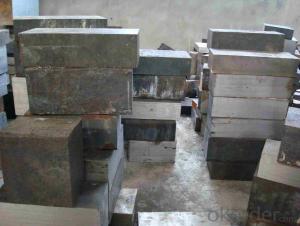Prime quality square alloy steel billet 120mm Q235
- Loading Port:
- Tianjin
- Payment Terms:
- TT OR LC
- Min Order Qty:
- 100 m.t.
- Supply Capability:
- 10000 m.t./month
OKorder Service Pledge
OKorder Financial Service
You Might Also Like
Structure of Prime quality square alloy steel billet 120mm Q235

Description of Prime quality square alloy steel billet 120mm Q235
1. Prepainted steel coil is coated with organic layer, which provides higher anti-corrosion property and a longer lifespan than that of galvanized or galvalume steel sheets.
2. The base metals for prepainted steel coil consist of cold rolled, HDGI Steel, electro-galvanized and hot-dip alu-zinc coated steel. The finish coats of prepainted steel coil can be classified into groups as follows: polyester, silicon modified polyesters, polyvinylidene fluoride, high-durability polyester, etc.
3. The production process has evolved from one-coating-and-one-baking to double-coating-and-double-baking, and even three-coating-and-three-baking.
4. The color of the prepainted steel coil has a very wide selection, like orange, cream-colored, dark sky blue, sea blue, bright red, brick red, ivory white, porcelain blue, etc.
5. The prepainted steel coils can also be classified into groups by their surface textures, namely regular prepainted sheets, embossed sheets and printed sheets.

Main Feature of Prime quality square alloy steel billet 120mm Q235
Uncoated CR steel sheet
With the features of in line with the international highest standards in demension and shape, excellent surface finish and properties, the products are mainly used in home appliance and automobile industries.
Galvanized steel sheet(include HDG and EG)
With the features of good corrosion resistance, the products are mainly used in automobile, home appliance, electronics, building and machinery manufacture industries, etc.
Precoated steel sheet
With the features of enviromental protection and good processablility, long lasting surface durability, rich in colors, the products are maily used in building, home appliance and furniture industries, etc.
Applications of Prime quality square alloy steel billet 120mm Q235
Construction
Manufacture anticorrosion, industrial and civil architecture roof boarding, roof grille
Light industries
Home appliance's case, civil chimney, kitchen utensils
Auto industry
Corrosion resistant parts of cars
Agriculture
Food storage, meat and aquatic products' freezing and processing equipment
Commerce
Equipments to store and transport materials, and packing implements

Specifications of Prime quality square alloy steel billet 120mm Q235
Product | Prime quality square alloy steel billet 120mm Q235 |
Material Grade | SGCC / SGCH / DX51D+AZ, etc |
Thickness | 0.6-3.0mm |
Width | 500-1500mm |
Tolerance | Thickness: +/-0.02mm , Width:+/-2mm |
Zinc-coating | Z30-150g/m2 |
Technique | Raw material: Hot rolled steel coil --> Cold rolled_>hot dipped galvalume |
Surface | Dried, Chromated, Unoiled |
Spangle | Regular spangle , small spangle, zero spangle |
ID | 508MM 610MM |
Coil weight | 1-25MT |
Export package | Cardboard inner sleeves, Waterproof paper, galvanized steel covered and steel strip packed |
FAQ of Prime quality square alloy steel billet 120mm Q235
We have organized several common questions for our clients,may help you sincerely:
1. How Can I Visit There?
Our company is located in Tianjin City, China, near Beijing. You can fly to Tianjin Airport Directly. All our clients, from home or aboard, are warmly welcome to visit us!
2. How Can I Get Some Sample?
We are honored to offer you sample.
3. Why choose CNBM?
Our delivery time about 15-20days for standard sizes, if you have other requirements like hardness, quanity and width ,it is about 20-40days. But don't worry we also try our best for the delivery time ,because time longer and our cost is higher.
- Q:Can steel billets be used in high-temperature applications?
- Yes, steel billets can be used in high-temperature applications. Steel billets are typically made from carbon steel, which has good heat resistance properties. Carbon steel can withstand elevated temperatures without significant deformation or loss in strength. However, it is important to consider the specific grade and composition of the steel billets as different alloys may have varying temperature limits. Additionally, factors such as the duration of exposure to high temperatures, the presence of corrosive environments, and the mechanical loading conditions should be taken into account when determining the suitability of steel billets for high-temperature applications.
- Q:What are the main challenges in the handling of steel billets during production?
- The production of steel billets poses various challenges that must be addressed in order to achieve a streamlined and effective manufacturing process. Weight and size are major obstacles to consider when working with steel billets. These billets can be quite hefty, ranging from a few hundred kilograms to several tons, depending on their dimensions. As a result, lifting and moving them within the production facility can be difficult. The safe handling of these heavy loads necessitates the use of specialized equipment, such as cranes and forklifts. Another challenge lies in the potential for damage during the handling of steel billets. They are typically transported and stored in stacks or bundles, and improper handling techniques or inadequate protection can result in deformation, scratches, or even breakage of the billets. These damages can negatively impact the quality of the final product, leading to increased scrap rates and production costs. Furthermore, maintaining precise temperature control is crucial when working with steel billets. Steel is highly sensitive to temperature changes, and the billets must be kept within specific temperature ranges to prevent distortion or metallurgical issues. Careful attention must be paid when transferring billets between different areas of the production facility to ensure consistent temperatures. Proper inventory management and tracking also present challenges in the handling of billets. Steel billets are often stored in large warehouses or outdoor yards, and keeping track of their location, quantity, and quality can be complex. Efficient inventory management systems, such as barcoding or RFID tagging, are essential to minimize errors and facilitate the retrieval of the necessary billets for production. Lastly, safety is a significant concern when handling steel billets. The weight of the billets and the potential for injury make it imperative to adhere to strict safety protocols. Operators must receive proper training on the use of equipment, such as cranes and forklifts, and wear appropriate personal protective equipment (PPE) to prevent accidents or injuries. In conclusion, the handling of steel billets during production presents challenges related to weight, potential damage, temperature control, inventory management, and safety. Overcoming these challenges necessitates investments in specialized equipment, training, and efficient processes to ensure a smooth and successful production operation.
- Q:How do steel billets contribute to the chemical industry?
- The chemical industry heavily relies on steel billets as a vital raw material for the production of various chemicals and chemical products. These solid bars or rods of steel play a critical role in the manufacturing process. To begin with, in chemical production plants, steel billets are utilized in the fabrication of reactors and vessels. These reactors are specifically designed to withstand extreme temperatures and pressure. Steel billets provide the necessary strength and durability to ensure the integrity of these applications. The chemical reactions occurring within these reactors often involve corrosive or harsh chemicals, and the use of steel billets guarantees that the equipment remains intact, preventing any potential leaks or accidents. Furthermore, steel billets are also essential in the production of catalysts, substances that facilitate chemical reactions without being consumed in the process. Many catalysts are composed of metals or metal oxides, and steel billets are commonly employed as the foundational material for their manufacturing. By providing a stable and robust foundation, steel billets contribute to the efficiency and effectiveness of these catalysts. Additionally, steel billets are employed in the construction of pipelines and storage tanks, which are crucial for the transportation and storage of chemicals. These structures must withstand high pressures and corrosive environments, making steel billets the preferred material due to their strength, durability, and resistance to chemical degradation. They ensure the secure and efficient transportation and storage of chemicals, which is of utmost importance in the chemical industry. In conclusion, steel billets are indispensable in the chemical industry due to their strength, durability, and resistance to chemical degradation. They are utilized in the construction of reactors, vessels, catalysts, pipelines, and storage tanks, all of which are vital components of chemical production and transportation. Without steel billets, the chemical industry would face significant challenges in operating efficiently and safely.
- Q:What are the main factors affecting the wear resistance of steel billets?
- The wear resistance of steel billets can be influenced by several key factors. Firstly, the composition of the steel plays a crucial role. The presence of specific alloying elements, like chromium, manganese, and molybdenum, greatly enhances the steel's wear resistance. These elements form carbides and other compounds that create a durable and hard surface capable of withstanding abrasion. In addition, the microstructure of the steel is vital in determining its wear resistance. Fine-grained steels tend to have better wear resistance due to their smaller grain size, which provides a more uniform and dense structure, reducing the likelihood of cracks and wear. Heat treatment processes, such as quenching and tempering, can further refine the microstructure and enhance wear resistance. The surface finish also affects wear resistance. A smooth and well-polished surface reduces friction between the steel billet and its surroundings, minimizing wear. Various machining techniques, such as grinding and polishing, can be used to achieve the desired surface finish. Furthermore, the hardness of the steel billet is a significant factor in wear resistance. Hardness is commonly measured using the Rockwell or Brinell scales, and higher hardness values generally indicate improved wear resistance. Heat treatment, alloying, and the addition of hardening agents can all help increase the hardness of the steel billet. Lastly, environmental factors can impact wear resistance. The presence of corrosive substances, high temperatures, or abrasive particles in the working environment can accelerate wear and reduce the lifespan of the steel billet. Implementing appropriate coatings, like chromium plating or thermal spraying, can mitigate these environmental effects and enhance wear resistance.
- Q:How do steel billets contribute to the manufacturing of HVAC systems?
- Steel billets are used in the manufacturing of HVAC systems as they provide the raw material required for fabricating various components such as ductwork, heating coils, and air conditioning units. Billets are melted down and then shaped into the desired form, allowing manufacturers to create durable and sturdy components that can withstand the demanding conditions of HVAC systems. Additionally, steel billets offer excellent thermal conductivity, allowing for efficient heat transfer within the system, ultimately contributing to the overall performance and energy efficiency of HVAC systems.
- Q:What is the typical size and shape of steel billets?
- Steel billets typically have a rectangular or square shape and come in various sizes. The most common sizes range from 100mm x 100mm to 300mm x 300mm, with lengths typically ranging from 3 meters to 12 meters. However, the size and shape of steel billets can vary depending on the specific requirements of the steel production process and the intended use of the billets.
- Q:Can steel billets be used in the production of aerospace components?
- Indeed, the utilization of steel billets is feasible for the manufacturing of aerospace components. These semi-finished steel products can undergo further processing to attain an assortment of shapes and sizes. Notably, their application is widespread across industries such as aerospace, automotive, and construction. Within the aerospace sector, steel billets serve as the foundation for fabricating shafts, gears, and structural parts. Nevertheless, it is imperative to acknowledge that the steel variant employed in aerospace must adhere to stringent criteria encompassing strength, durability, high-temperature resistance, and corrosion resistance. Consequently, steel billets employed in aerospace production necessitate supplementary treatments such as heat treatment, machining, and surface finishing to attain the desired properties and dimensions. Overall, while the utilization of steel billets is feasible for aerospace component manufacturing, it is crucial to ensure that the steel material and manufacturing processes conform to the stipulated specifications and standards to guarantee safety and performance within the aerospace industry.
- Q:Our caster is square billet! 150X500! That is, every time we open the head, there is slag inclusion. And pores! Yes, the first 3 meters! There's no more left behind! How did it happen, please?! We have a refinery and electromagnetic stirring! Give me a hand!
- In the production process of steel castings, the appearance of quality defects is unavoidable. It is essential to take reasonable measures to avoid the inclusion of slag in the cast steel. It is necessary to understand the reason why the porosity of the cast steel is caused by slag inclusion so that the quality of the cast steel can be improved.In order to solve the pinhole of slag phenomenon, the first thing to do is to understand the cause of steel casting porosity slag phenomenon, and take corresponding measures according to the original material,
- Q:How do steel billets contribute to the shipbuilding industry?
- The shipbuilding industry heavily relies on steel billets, which have a significant role in the construction of ships. These semi-finished products are molten steel that has solidified into a specific shape, usually a square or rectangular block. They are obtained through continuous casting or ingot casting. Steel billets play a crucial role in providing the raw material for fabricating various ship components. These billets undergo further processing, such as rolling, forging, or extrusion, to create different structural elements like plates, beams, angles, and channels. These components are then used in constructing the ship's hull, decks, bulkheads, and other structural parts. Moreover, steel billets possess advantageous properties that make them ideal for shipbuilding. Their high strength and durability ensure the ship's structural integrity and longevity, enabling it to withstand the harsh marine environment and constant exposure to seawater. Additionally, steel billets have excellent weldability, facilitating efficient and reliable joining of different components during ship assembly. Furthermore, the use of steel billets in shipbuilding offers a cost-effective solution. Steel is readily available and abundant, making it a cost-efficient material choice for ship construction. Furthermore, steel is highly recyclable, allowing for the reuse of steel billets and reducing environmental impact. In conclusion, steel billets are essential in the shipbuilding industry as they provide the raw material for fabricating various ship components. Their high strength, durability, weldability, and cost-effectiveness make them an ideal choice for constructing ships that can withstand the demanding marine environment. Ultimately, steel billets contribute to the safe and reliable operation of ships, supporting the growth and development of the shipbuilding industry.
- Q:How do steel billets contribute to the manufacturing of defense equipment?
- The role of steel billets in the manufacturing of defense equipment cannot be overstated. These semi-finished steel products serve as vital raw materials in various manufacturing processes. In order to meet the demands of defense equipment, materials must possess strength, durability, and the ability to withstand extreme conditions. Steel billets fulfill these requirements flawlessly. When it comes to defense manufacturing, steel billets are primarily utilized in the production of armored vehicles and tanks. The construction of these vehicles necessitates resistance against ballistic threats and the ability to protect soldiers inside. Steel billets, known for their exceptional strength and toughness, are the optimal choice for manufacturing armor plates used in these vehicles. Through the transformation of billets into thick, hardened steel plates, excellent ballistic resistance is achieved, enabling them to withstand high-velocity impacts. Furthermore, steel billets play a crucial role in the production of weaponry, including firearms and missiles. These weapons require materials capable of handling the intense pressure and heat generated during firing or launching. Steel billets, possessing high tensile strength and heat resistance, provide the necessary foundation for creating barrels, chambers, and other critical components of these weapons. In addition, steel billets contribute to the manufacturing of defense equipment by being employed in the production of various support structures and infrastructure. This encompasses military facilities, such as hangars, barracks, and storage facilities, which demand robustness and security. Steel billets are transformed into beams, columns, and other structural elements that provide strength and stability to these buildings. To summarize, steel billets are an indispensable component in defense equipment manufacturing. Their strength, durability, and capacity to withstand extreme conditions make them ideal for producing armored vehicles, weaponry, and support structures. By utilizing steel billets, defense manufacturers can ensure the production of high-quality, reliable equipment that meets the stringent requirements of the defense sector.
1. Manufacturer Overview |
|
|---|---|
| Location | |
| Year Established | |
| Annual Output Value | |
| Main Markets | |
| Company Certifications | |
2. Manufacturer Certificates |
|
|---|---|
| a) Certification Name | |
| Range | |
| Reference | |
| Validity Period | |
3. Manufacturer Capability |
|
|---|---|
| a)Trade Capacity | |
| Nearest Port | |
| Export Percentage | |
| No.of Employees in Trade Department | |
| Language Spoken: | |
| b)Factory Information | |
| Factory Size: | |
| No. of Production Lines | |
| Contract Manufacturing | |
| Product Price Range | |
Send your message to us
Prime quality square alloy steel billet 120mm Q235
- Loading Port:
- Tianjin
- Payment Terms:
- TT OR LC
- Min Order Qty:
- 100 m.t.
- Supply Capability:
- 10000 m.t./month
OKorder Service Pledge
OKorder Financial Service
Similar products
New products
Hot products
Related keywords

